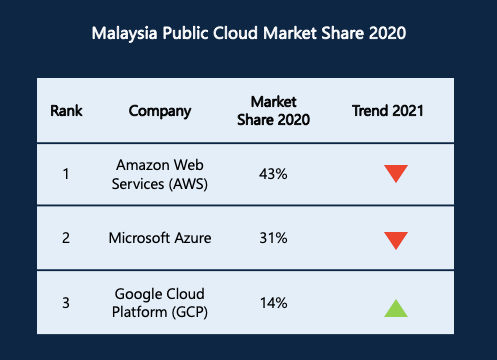Competitive overview
- Amazon Web Services (AWS), Microsoft Azure and Google Cloud Platform (GCP) account for 88% of the local public cloud IaaS market, translating to a value of US$142.91 million. The market concentration is expected to reduce by 4-7% as new market entrants improve their competitive positioning.
- AWS is the market leader holding 43% of the IaaS market share and continues to gain customers for its S3 and EC2 offerings. Microsoft Azure holds 31% of the market share with enterprise accounts thanks to the company’s established familiarity from their SaaS offerings.
- Despite entering the market later than its counterparts, GCP has gained big and notable contracts from the likes of Air Asia and Digi.com Bhd for their cost-effectiveness and open-source technology.
- The competition in the IaaS market is touted to increase in Malaysia as cloud providers like Huawei Malaysia start to provide locally hosted cloud services in collaboration with Telekom Malaysia via TM Cloud α (Cloud Alpha).
Leaders of Malaysia Public Cloud Infrastructure Market
Why are they leading?
Shifting the lens to cloud providers, AWS Malaysia continues to lead the IaaS market with customers from various industries such as media and entertainment, oil and gas and manufacturing. Their micro-focus on the digital native businesses in Malaysia is a key factor in their market leadership. This is because Malaysia is home to the highest percentage (83%) of digital consumers of its population in ASEAN. AWS has not only understood the digital landscape in Malaysia but has also gone above and beyond to cater to digital businesses, especially in the media and entertainment and e-commerce segments. Companies like Zalora and iflix deploy cloud services for their website content hosting through AWS.
Microsoft Azure, on the other hand, is exemplary when it comes to establishing a partner ecosystem. With over 96% of their IaaS revenue hailing from their Microsoft Partner Network (MPN), this company has established strong alliances with industry-leading partners such as rhipe solutions, Softline and SoftwareONE. These partnerships have allowed them to gain many enterprise accounts from various industries, namely, Maybank, Celcom and Sime Darby.
Despite not having a sizeable partner network like Azure, GCP is nurturing a few notable partners such as G-Asia Pacific and GoPomelo. However, GCP has been successful in gaining big accounts such as Air Asia, Digi.com Bhd and Malaysian Airlines. This is due to their versatile services with competitive pricing. GCP is also known for their bundling services better known as Google Cloud offerings, allowing organizations to mix and match services accordingly.
What about the rest?
In terms of the remainder 12% market shares, it is held by recent market entrants such as Alibaba Cloud and Huawei Cloud. Although Alibaba Cloud may only hold an estimated 3% of the market, this cloud provider has gained traction due to its local data centre, e-Commerce expertise and promises of top-class security. The cloud provider has also shown expertise in navigating through the Central Bank (BNM) RMiT regulations. With these factors, Alibaba Cloud managed to serve several FSI customers namely CIMB, TNG Digital and Revenue Monster – allowing it to be a contender for cloud services in FSI. On the other hand, Huawei Malaysia’s collaboration with TM Malaysia has resulted in TM Cloud α which looks to address the need for robust computing and data locality. These services may convert financial and public sector customers, who were earlier facing restrains by stringent cloud policies.
Twimbit takeaways
- With over 50% of the organizations in the SME sector still not on any form of cloud services. This vertical has high potential accounts that cloud service providers can target.
- A strong partner network is key for cloud providers to acquire a diverse set of enterprise accounts. This is because these companies have a high reliance on system integrators, IT advisors and independent software vendors.
- Due to the low entry barriers of the local cloud market, many cloud service providers are entering with competitive pricing and multifaceted services. In order to distinguish oneself from the concentrated market, cloud service providers need to focus their attention on specific verticals that would best use their offerings.
